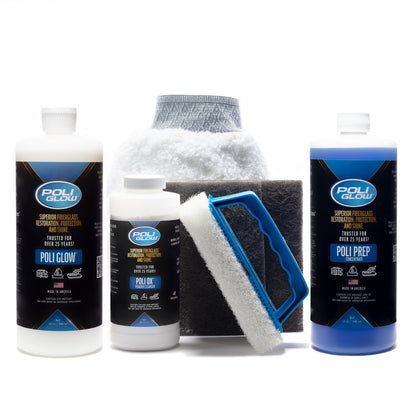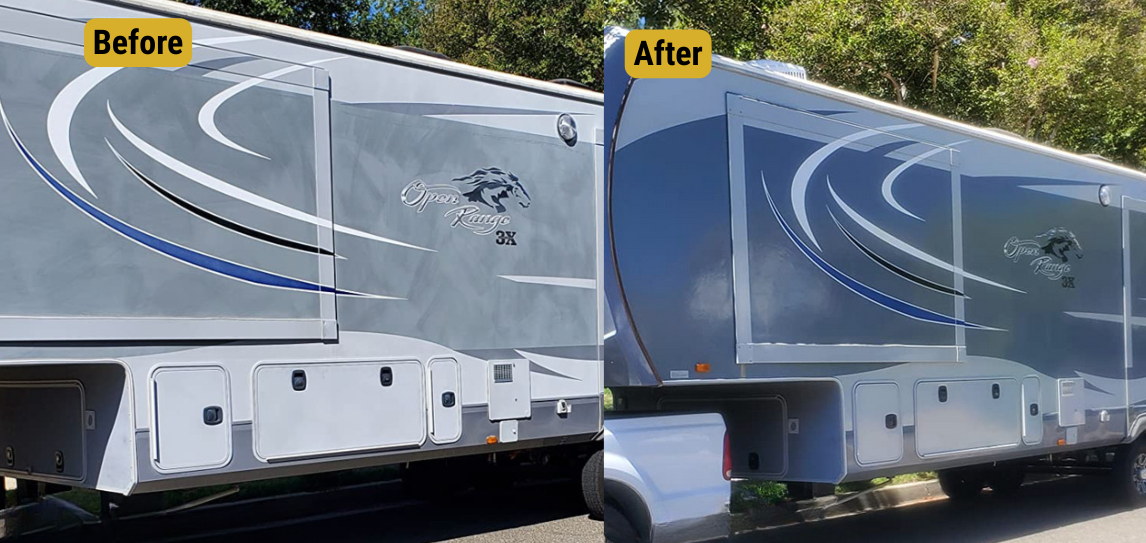
Breathing New Life: The Art of Fiberglass Boat Restoration Unveiled
Time to read 14 min
Fiberglass boats, renowned for their durability and lightweight build, inevitably face the test of time and elements. Prolonged exposure to sunlight, saltwater, and wear leads to the degradation of these boats, leaving them worn, faded, and structurally compromised. This is where the practice of restoration emerges as a pivotal solution. The process of fiberglass boat restoration, while intricate, ensures that these marine crafts not only regain their aesthetic appeal but also maintain structural integrity. This article delves into the meticulous art of fiberglass boat restoration, guiding enthusiasts and owners through the nuances and critical steps involved in breathing new life into their cherished vessels.
Understanding Fiberglass: A Quick Primer
Fiberglass, also known as glass-reinforced plastic (GRP), is a composite material made by embedding glass fibers within a polymer matrix. The glass fibers confer structural integrity and strength to the material, while the polymer matrix, usually composed of epoxy or polyester resin, binds the fibers and imparts elasticity. This composite yields a lightweight yet robust material with notable corrosion resistance, rendering it suitable for the demanding conditions of marine environments where contact with moisture and saltwater is constant.
One of the distinct attributes of fiberglass is its remarkable flexibility in design. Manufacturers can shape it into diverse forms and sizes, accommodating various boat styles and purposes. This flexibility, combined with its relatively low cost compared to conventional materials such as wood or metal, has contributed to the widespread utilization of fiberglass in boat construction. In contrast to materials demanding constant upkeep, fiberglass also necessitates relatively limited maintenance. Frequent painting or sealing is unnecessary, reducing maintenance costs and effort for boat owners.
Fiberglass has transformed the landscape of boat construction by offering a harmonious blend of strength, versatility, and cost-effectiveness. Its capacity to endure harsh maritime conditions while accommodating various designs has firmly established fiberglass boats as a permanent fixture within the maritime realm, exemplifying a seamless fusion of ingenuity and pragmatism.
The Signs Your Fiberglass Boat Needs Restoration
Recognizing the signs that indicate your vessel's need for restoration is vital to upholding its aesthetic appeal and seaworthiness. Let's navigate through the discernible cues that suggest it's time to breathe new life into your cherished fiberglass companion.
- Gelcoat Deterioration: The gel coat, a protective layer on fiberglass boats, may show signs of fading, chalkiness, or hairline cracks over time. These issues, if not addressed, can lead to more substantial problems.
- Blister Formation: Blisters can emerge below the gel coat due to osmotic reactions. While they vary in size, untreated blisters pose structural risks.
- Soft Spots on Deck: Soft or spongy sensations when stepping on the deck suggest water damage, compromising the boat's structural integrity.
- Visible Cracks: Cracks extending beyond the superficial level in the gel coat indicate potential structural concerns and risk water penetration.
- Delamination: Delamination refers to the separation of fiberglass layers. Affected areas might produce a hollow sound upon tapping.
- Stains and Discoloration: Stains around hardware indicate the possibility of water infiltration and subsequent corrosion.
- Wood Damage: Wooden components in fiberglass boats, such as transoms or stringers, displaying signs of rot or water damage necessitate attention.
- Presence of Mold and Mildew: Continuous mold and mildew formations suggest issues with moisture, possibly due to leaks or inadequate ventilation.
- Hardware Corrosion: Corrosion in hardware components may be causing damage to adjacent fiberglass areas.
- Performance Decline: A noticeable decline in boat handling or increased sluggishness in water suggests potential hull complications.
- Persistent Leaks: Any consistent leakage indicates a breach in the boat's structural integrity, necessitating a thorough assessment.
- Outdated Electronics and Systems: Malfunctioning or aged electronics and systems may hint at broader neglect in the boat's maintenance.
For any of these signs, seeking consultation from a marine professional or a boatyard specializing in fiberglass boat restoration is recommended. They can comprehensively assess and advise on the requisite repairs or restoration procedures.
The Restoration Process Step-By-Step

Fiberglass boats are renowned for their durability and resilience. However, like all marine vessels, they are susceptible to wear and tear over time. Factors such as prolonged exposure to the elements, mechanical stresses, and general usage can lead to various forms of damage. A systematic restoration process can revitalize these boats, addressing both aesthetic and structural concerns.
Here’s an overview of the comprehensive steps that are integral to restoring fiberglass boats:
- Assessment: Begin with a thorough inspection of the entire surface. Identify and document areas of damage, such as cracks, blisters, delamination, and soft spots. This step determines the extent of restoration required.
- Safety Precautions: Before starting any restoration work, ensure the workspace is well-ventilated. Use protective equipment such as gloves, safety glasses, and a dust mask, especially when sanding fiberglass.
- Cleaning: Clean the boat thoroughly using a marine detergent. This step removes dirt, grease, and other contaminants, preparing the fiberglass surface for further work.
- Removing Old Paint and Gelcoat: If the boat's paint or gel coat is damaged or aged, it needs removal. Use a chemical stripper or a mechanical sander. Remember to work in small sections to maintain control.
-
Repair Damages:
- For Blisters: Drain the fluid, dry the area, and then fill with a suitable filler.
- For Cracks and Holes: Clean the affected areas and fill them with a fiberglass repair kit. Ensure any repairs maintain the structural integrity of the boat.
- For Delamination: Remove the delaminated section and replace it with new fiberglass layers, ensuring proper adhesion between layers.
- Sanding: Once repairs are complete and dry, sand the entire boat's outer surface. Start with a coarse grit and progress to finer grits, ensuring a smooth finish.
- Reapplying Gelcoat: Mix the gel coat as per the manufacturer's instructions. Apply evenly using a brush or sprayer. Multiple coats may be necessary for optimal results.
- Wet Sanding and Buffing: After the gelcoat has cured, wet sand the surface, starting with fine-grit sandpaper and progressing to even finer grits. Buffing the surface post-sanding ensures a glossy finish.
- Reapplying Paint: If you're painting over the gel coat, choose marine-grade paint. Apply using a brush or sprayer, ensuring even coats.
- Reinstall Hardware: Once the paint and gel coat is fully cured, reinstall any removed hardware, like cleats, railings, and fixtures. Ensure all fittings are securely fastened and sealed to prevent water ingress.
- Final Inspection: Conduct a thorough inspection of the boat, ensuring all areas are restored to satisfaction and that there are no missed spots.
- Regular Maintenance: After restoration, regular maintenance is key. Clean the boat regularly, inspect for any new damages or light scratches, and address issues promptly to extend the boat's lifespan.
The process of restoring fiberglass boats can be intricate. If uncertain about the process, it’s prudent to consult a marine expert to ensure the safety and longevity of your vessel.
Choosing the Right Materials and Tools

For an effective fiberglass boat restoration, one needs a combination of specialized tools and materials designed to cater to the unique requirements of fiberglass restoration. Here's a comprehensive list of the tools and materials required to complete this task:
- Safety Equipment:
- Gloves: To protect hands from sharp fiberglass strands and chemicals.
- Safety Glasses: To shield eyes from debris, especially during sanding.
- Dust Mask or Respirator: Essential when sanding fiberglass or using chemicals to prevent inhalation of particles or fumes.
- Cleaning Supplies:
- Marine Detergent: Formulated to remove grease, grime, and marine deposits.
- Scrub Brushes and Sponges: Useful for thorough cleaning.
- Repair Tools:
- Sanding Tools: Both manual sanding blocks and electric sanders are valuable for smoothing surfaces.
- Utility Knives and Scissors: For trimming and cutting fiberglass mats or cloth.
- Rollers and Brushes: For applying resin, gel coat, and paint.
- Materials for Repairs:
- Fiberglass Mat or Cloth: Essential for patching holes or reinforcing weakened areas.
- Resin and Hardener: The combination creates a solid bond when repairing with fiberglass.
- Gel coat: A protective layer applied to the exterior of fiberglass boats.
- Fillers: Useful for addressing minor imperfections or dents.
- Paint Supplies:
- Marine-grade Paint: Specifically formulated to withstand the marine environment.
- Paint Trays and Rollers: For evenly applying paint.
- Painter's Tape: To mask off areas not intended for painting.
- Finishing Supplies:
- Buffing Pads and Compounds: To achieve a glossy and smooth finish after painting or gel coat application.
- Polishing Compound: Helps in achieving a high-gloss finish.
- Miscellaneous Tools:
- Screwdrivers and Wrenches: Useful for removing and reattaching hardware.
- Containers: For mixing resins, hardeners, and other compounds.
- Measuring Cups and Stir Sticks: Necessary for achieving the correct mix ratios.
- Chemical Strippers: Used when removing old paint or gel coat. Always follow the manufacturer's recommendations and safety precautions when using these products.
It's important to note that the specific tools and materials required may vary based on the extent and nature of the restoration.
Gel Coat Repairs and Reapplication
The gel coat plays an integral role in fiberglass boats, both functionally and aesthetically. It acts as a protective shield, preventing water intrusion and mitigating damage from UV radiation. This not only ensures the longevity of the fiberglass but also provides resistance against everyday wear and tear. Beyond its protective attributes, the gel coat bestows a polished, high-gloss finish, elevating the boat's visual appeal. Furthermore, its smooth consistency offers the added advantage of easier maintenance and cleaning. While the boat derives its primary structural strength from the fiberglass layers, the gel coat supplements this with additional rigidity, ensuring the vessel retains its shape. Overall, the gel coat is indispensable, influencing the boat's appearance and operational performance.
Gel coat damages can range from minor scratches to significant cracks or gouges. Here's how to address them:
-
Minor Scratches:
- Clean the scratched area with a marine detergent.
- Sand the scratch lightly using fine-grit sandpaper (usually 600 grit or higher).
- Use a rubbing compound to polish the sanded area, followed by waxing for shine.
-
Chips and Small Gouges:
- Begin by cleaning the area thoroughly.
- Mix a small amount of gel coat with the appropriate hardener.
- Fill the chip or gouge with the mixed gelcoat using a spatula or putty knife, ensuring it's slightly overfilled.
- Allow it to cure as per the manufacturer’s recommendations.
- Sand the repaired area, starting with medium-grit sandpaper and progressing to a fine-grit, ensuring it's flush with the surrounding gel coat.
-
Large Cracks and Damages:
- Clean the affected area.
- If the damage penetrates through the gel coat and into the fiberglass, it's essential first to repair the fiberglass using a suitable repair kit.
- Once the fiberglass repair has cured, sand the area smoothly.
- Apply the gel coat as you would for chips and small gouges, ensuring full coverage of the repaired area.
- Allow it to cure and sand it smooth, blending it with the surrounding gel coat.
For an effective gel coat application on fiberglass boats, meticulous preparation is pivotal. Here are some best practices for gel coat applications:
- Preparation: Ensure the surface is clean, dry, and contaminant-free. Sand the area with a medium to fine-grit sandpaper to enhance adhesion.
- Mixing: Accurately mix the gel coat with its hardener according to the manufacturer’s recommendations. Inaccurate ratios can affect curing and the final finish.
- Application Tools: Use brushes, rollers, or sprayers depending on the size and the desired finish. Brushes and rollers are suitable for small repairs, while sprayers are ideal for larger areas or reapplying gel coats over the entire boat.
- Temperature and Humidity: It's crucial to apply the gel coat in an environment within the temperature and humidity ranges specified by the manufacturer. Extreme conditions can affect curing and the final appearance.
- Curing: Allow the gel coat to cure fully before sanding or buffing. This ensures maximum hardness and durability.
- Finishing: After curing, wet sand the gel coat, starting with fine-grit sandpaper and progressing to ultra-fine grits. Buff and polish to achieve a high-gloss finish.
The Importance of Proper Finishing
Proper finishing is a pivotal phase in any project involving materials like wood, metal, or fiberglass. It elevates the visual appeal, extends longevity, provides protection, and enhances overall quality. Here are its primary advantages:
- Aesthetic Appeal: A well-finished boat exhibits a polished and pristine appearance. The glossy surface elevates the boat's visual appeal and reflects a commitment to meticulous upkeep.
- Surface Protection: Proper finishing protects against environmental factors like UV radiation, salt water, and airborne contaminants. This protective barrier prolongs the lifespan of the boat's materials, minimizing wear and deterioration.
- Enhanced Durability: A carefully finished surface ensures that the underlying layers, including the gel coat and fiberglass, have been correctly applied and sealed. This can result in a more resilient structure that can better withstand the rigors of marine environments.
- Maintenance Efficiency: A boat with a properly finished surface simplifies cleaning and maintenance routines. Contaminants and marine growths are less likely to adhere to a smooth and well-finished surface, making them easier to remove.
- Resale Value: A boat that exhibits a high standard of finishing is likely to retain its value better over time. Potential buyers often perceive a well-maintained and finished boat as a testament to the owner's commitment to quality care.
- Optimal Performance: A smooth surface can impact the boat's hydrodynamics, ensuring smoother movement through water and potentially improved fuel efficiency.
A proper finish is not just a superficial enhancement. It's a pivotal aspect affecting the boat's aesthetics, durability, performance, and overall value, making it indispensable for boat enthusiasts and professionals.
Long-Term Maintenance and Care
Adopting a consistent long-term maintenance and care routine is essential to ensure your boat retains its function and appearance over the years. The following are the main components of such a regimen:
- Routine Inspections: Regularly inspect the boat for signs of wear, damage, or potential issues. This includes checking the hull for cracks, inspecting fittings for corrosion, and ensuring seals remain watertight.
- Cleaning: Wash the boat regularly with marine-specific cleaners to remove salt, grime, and other contaminants. This prevents corrosion and maintains the boat's aesthetic appeal.
- Gelcoat Maintenance: Periodically inspect the gel coat for signs of mild or severe oxidation or damage. Regular polishing and waxing can help retain its luster and protective properties.
- Anti-fouling: To prevent marine organisms from attaching to the hull, apply an anti-fouling paint as needed, typically once a year or per the manufacturer's recommendation.
- Engine Care: Regularly service the boat's engine, checking for any issues and ensuring it's well-lubricated. Replace parts as needed and follow manufacturer guidelines for routine maintenance.
- Upholstery and Interior Care: Vacuum and clean the boat's interior regularly. Protect upholstery from UV rays and moisture, and treat leather and fabric with appropriate protectants.
- Electrical Systems: Ensure all electrical systems and components are in optimal working condition. Address any issues immediately to prevent more significant problems in the future.
- Storage: When not in use, store the boat in a covered area or use a boat cover to protect it from UV rays, moisture, and other environmental factors.
- Equipment Checks: Regularly inspect safety equipment, such as life jackets, flares, and fire extinguishers, to ensure they're in good condition and replace expired items.
- Documentation: Keep a logbook of all maintenance activities, including dates and specifics of each task. This provides a reference for future care and can enhance resale value by demonstrating meticulous upkeep.
A disciplined approach to long-term maintenance and care ensures a boat remains in optimal condition, offering reliable performance and retaining its aesthetic appeal over the years.
The Environmental and Economic Benefits of Fiberglass Boat Restoration
Restoring fiberglass boats, rather than replacing them, offers several environmental and economic advantages:
- Resource Conservation: Restoration extends the lifespan of a boat, reducing the demand for new materials. This conserves resources like fiberglass, resin, and other manufacturing materials, leading to decreased extraction and processing.
- Waste Reduction: By restoring an existing boat, fewer boats are discarded or abandoned. This diminishes waste in landfills and reduces the environmental footprint associated with boat disposal.
- Energy Savings: Manufacturing new boats requires significant energy, from raw material extraction to construction. Restoring existing boats consumes far less energy in comparison.
- Cost Efficiency: From an economic standpoint, restoration is generally more cost-effective than purchasing a new boat. This allows boat owners to maximize the value of their initial investment.
- Job Creation: The boat restoration industry creates specialized jobs, from skilled artisans to marine technicians, fostering economic growth in the sector.
- Reduced Carbon Footprint: Given that the manufacturing and transport of new boats emit considerable greenhouse gases, restoration can significantly lower the carbon footprint by circumventing the need for new production.
- Market Value: A well-restored boat can retain or increase its market value. This benefits boat owners economically, particularly if they decide to sell.
- Promotion of Sustainable Practices: Restoration fosters a culture of repair and reuse, encouraging sustainable practices within the marine industry and among consumers.
Fiberglass boat restoration not only extends the life of a boat but also presents both environmental and economic benefits. It reduces waste, conserves resources, saves energy, and is a cost-efficient alternative to replacement, making it a beneficial practice for both boat owners and the environment.
When to DIY vs. Hiring a Professional for Boat Maintenance and Restoration
Navigating the decision between undertaking a DIY approach and hiring a professional for boat maintenance and restoration is contingent on several factors:
- Skill Level and Experience: Assess your own knowledge and proficiency concerning boat repairs and maintenance. Simple tasks like cleaning, minor gel coat repairs, or basic equipment replacements might be manageable for those with basic skills. However, more intricate repairs or restorations may demand specialized knowledge and experience.
- Tools and Equipment: Consider the tools required for the job. While basic maintenance tasks might necessitate only common tools, more advanced repairs can require specialized equipment. If you lack these tools or the expertise to use them, hiring a professional might be the logical choice.
- Scale of the Project: Minor tasks such as patching small areas or replacing a light fixture can be feasible DIY projects. However, extensive restorations or overhauls often warrant professional intervention, especially those involving structural integrity or major system replacements.
- Safety Considerations: Safety should always be paramount. Tasks involving electrical systems, engine repairs, or anything compromising the safety of the boat or its passengers should be approached with caution. If you're unsure about any aspect, consult or hire a professional.
- Time Commitment: While DIY can be cost-effective, it might be time-consuming, especially for those unfamiliar with the task at hand. Evaluate the time you can dedicate to the project and weigh it against the convenience of hiring a professional.
- Cost Implications: DIY can offer cost savings in terms of labor. However, mistakes due to inexperience might lead to further damages and additional costs in the long run. Acquiring specialized tools or equipment solely for a one-time repair also negates potential savings.
- Warranty and Insurance Concerns: When done without professional oversight, some boat repairs might void warranties or not meet insurance criteria. Always check warranty stipulations and insurance policies before embarking on DIY repairs.
- Quality and Longevity: While DIY repairs can be satisfactory for minor issues, professional work often ensures longevity and a higher quality standard, especially for significant restorations or repairs.
Deciding between a DIY approach and hiring a professional for boat maintenance and restoration depends on the task's complexity and the individual's expertise. A DIY method might be appropriate for minor tasks or if one possesses the necessary skills and tools. However, engaging a professional becomes the prudent choice when faced with extensive projects, safety implications, or the need for specialized knowledge. Carefully evaluating these factors ensures that the boat's safety, integrity, and value remain uncompromised.
When it comes to fiberglass boat restoration, Poli Glow® emerges as a transformative option. Poli Glow®, a specialized restoration and protection system, holds immense potential for breathing new life into fiberglass boats. Its distinctive process, involving products such as Poli Prep®, Poli Ox®, and Poli Glow®, is tailored to eliminate oxidation, prepare surfaces, and seal them to achieve a radiant high-gloss finish. Beyond conventional polishes, Poli Glow® demonstrates remarkable adhesion capabilities, providing robust and enduring safeguarding against oxidation while revitalizing the visual allure of older boats. Trusted by boat enthusiasts, this solution stands as a reliable choice to unveil the art of restoring and preserving the captivating essence of fiberglass boats.






